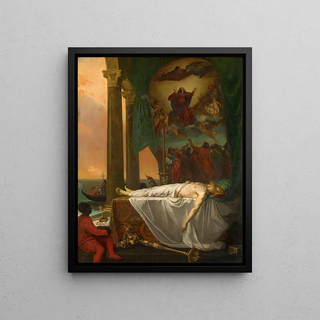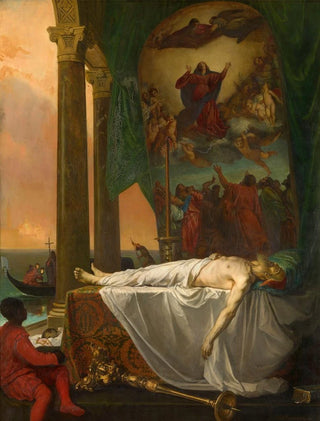Art print | Titian reclining at the Barbarigo Palace - Joseph Nicolas Robert-Fleury


View from behind

Frame (optional)
The art print of Titien reclining at the Barbarigo Palace - Joseph Nicolas Robert-Fleury evokes a work imbued with emotional depth and historical richness. This painting, which belongs to the tradition of great masters of painting, transports us to the heart of the Renaissance, an era when art was both a reflection of society and a means of personal expression. The depiction of Titien, the renowned Venetian painter, in a state of repose, raises questions about the nature of life and death, while celebrating the beauty of the human body. Robert-Fleury's work, through its fidelity and respect for the original, offers us a fascinating window into this artistic period, while paying homage to Titien's legacy.
Style and uniqueness of the work
Robert-Fleury's style is distinguished by meticulous attention to detail and a vibrant color palette that captures light in an almost sensory way. In this art print, he manages to recreate the intimate atmosphere emanating from the original painting, while adding his own touch of modernity. The drapery, skin texture, and play of shadow and light are rendered with such precision that they seem almost tangible. This striking realism, combined with harmonious composition, allows the viewer to enter Titien's universe, while being aware of Robert-Fleury's virtuosity. Each brushstroke demonstrates technical mastery that transcends the simple exercise of reproduction to become a work in its own right, celebrating art in all its splendor.
The artist and his influence
Joseph Nicolas Robert-Fleury, a 19th-century painter, is often recognized for his ability to merge tradition and innovation. Trained in the shadow of past masters, he knew how to absorb classical techniques while adapting them to his era. His work is marked by a desire to pay tribute to the great artists who preceded him, while seeking to evolve the pictorial language. The art print of Titien reclining at the Barbarigo Palace bears witness to this duality, where the legacy of the Renaissance meets the artistic aspirations of

Matte finish

View from behind

Frame (optional)
The art print of Titien reclining at the Barbarigo Palace - Joseph Nicolas Robert-Fleury evokes a work imbued with emotional depth and historical richness. This painting, which belongs to the tradition of great masters of painting, transports us to the heart of the Renaissance, an era when art was both a reflection of society and a means of personal expression. The depiction of Titien, the renowned Venetian painter, in a state of repose, raises questions about the nature of life and death, while celebrating the beauty of the human body. Robert-Fleury's work, through its fidelity and respect for the original, offers us a fascinating window into this artistic period, while paying homage to Titien's legacy.
Style and uniqueness of the work
Robert-Fleury's style is distinguished by meticulous attention to detail and a vibrant color palette that captures light in an almost sensory way. In this art print, he manages to recreate the intimate atmosphere emanating from the original painting, while adding his own touch of modernity. The drapery, skin texture, and play of shadow and light are rendered with such precision that they seem almost tangible. This striking realism, combined with harmonious composition, allows the viewer to enter Titien's universe, while being aware of Robert-Fleury's virtuosity. Each brushstroke demonstrates technical mastery that transcends the simple exercise of reproduction to become a work in its own right, celebrating art in all its splendor.
The artist and his influence
Joseph Nicolas Robert-Fleury, a 19th-century painter, is often recognized for his ability to merge tradition and innovation. Trained in the shadow of past masters, he knew how to absorb classical techniques while adapting them to his era. His work is marked by a desire to pay tribute to the great artists who preceded him, while seeking to evolve the pictorial language. The art print of Titien reclining at the Barbarigo Palace bears witness to this duality, where the legacy of the Renaissance meets the artistic aspirations of






